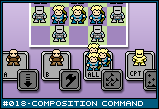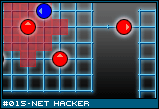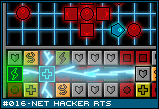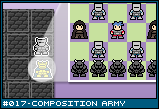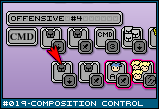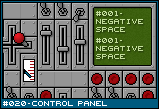| Three Hundred |
| - Index Page |
| - About... |
| - By Year |
| Collections |
| - Comp-Grid |
| - Procedural |
| - Tactics |
| - Tiny Crawl |
| - Misc |
| Previous | Mechanic #018 | Next |
The Composition Grid series is a group of gameplay mechanics that revolve around customization of one's game or abilities by placing objects at specific places on a grid. Where these objects are on the grid, as well as where they are in relation to each other, makes as much of a difference as what those objects are in the first place. This entry builds on #017 - Composition Army by adding a command queue allowing one to organize a more concentrated attack.
![[cmd1.png]](set01/img/entry018-cmd1.png) The first thing that needs to be addressed is that there needs to be an easy way to switch formation. Each captain has a number of formation slots, into which the player can build a unique formation in each one. This captain has four formation slots (A, B, C, D for easy reference). You can move (at half speed) while switching formations, but you can't attack. Formations may also be rotated clockwise or counter-clockwise 90 degress, but at the cost of moving. A is a general purpose formation, used for most general purpose attacks. Formation B is a defensive formation, putting the archers and captain in the center surrounded by melee units. Formation C is a front heavy attack formation and Formation D is just... well, I'm not sure, but it seemed like a good idea at the time. In addition to the four different formation slots, there are three labels that can be applied: BALANCED, OFFENSIVE, and DEFENSIVE. So, you'd probably apply the OFFENSIVE label to Formation C. These three types of formations are essentially defaults and may be automatically enforced or required depending on the situation. For instance, after a critical attack from the rear, the unit may automatically move to the labelled DEFENSIVE formation. Or perhaps the Captain has a special attack which puts the unit into OFFENSIVE formation and then charges forward for additional damage.
In addition to formations, each captain has a number of slots in which they can hold special maneuvers. These maneuvers represent battle field actions that have been planned out in advance, not unlike a playbook for a sports game. Enacting one of these maneuvers requires command points, a pool belonging to the captain that replenishes over time (these would be separate from spell points or action points used by the captain for his own special abilities). ![[cmd2.png]](set01/img/entry018-cmd2.png) At the most basic, a battle field maneuver is a simple queue of actions that have been saved in advance. The size of the queue depends on the captain, and each action in the queue requires a specific number of command points to pull off. The total cost per maneuver is calculated by simply adding all these numbers up. Therefore, it would be wise to have both quick and dirty maneuvers and more complex, but expensive ones. This action queue is a relatively simple one. It changes to the DEFENSIVE formation (formation C), does a 180 degree turn (putting the gold knight captain at the front), and then attacks with the default attack. You could specify formation C directly, but then if you wished for a difference formation, you'd have to go in an edit this command. Instead, if you just specify DEFENSIVE formation, you'd only have to change which formation the label points to.
Of course, if all you could do was queue up simple formation commands, it wouldn't be very interesting, would it? ![[cmd3.png]](set01/img/entry018-cmd3.png) Here is a command queue which gives individual commands to units, overriding the order of attack (magic, ranged, then melee). Each box in the queue can order a specific unit, or a specific group of units. For instance, the first command orders all basic Knights (there are only three units on the box, but that is more to represent a group of Knights collectively). Likewise, the second box orders one of the Barbarians independently. Ordering a group of like-units costs more command points than ordering a single unit, but less than if you had ordered them individually. In addition to basic actions, as would happen in a basic attack action, some units have special abilities which can be called upon during a maneuver. The first two commands order all the Knights and Barbarian A to charge, an attack which causes them to rush forward, reducing their defensve and increasing their attack for each square they traverse. The second Barbarian is ordered to Cleave with his axe, hitting the first unit he meets and the two next to him. The Elven Archers are ordered to lay down suppressing fire, which does minimal damage to the entire enemy grid, and then the gold knight captain casts a firestorm spell shortly before the team goes into defensive formation. Since some of these attacks will have cooldown timers (like a wizard attack or that lovely firestorm spell), not every commanded action will be possible. Perhaps it could be possible to designate certain commands as required, such that if a spell is not ready, the maneuver will not be able to be performed.
|
